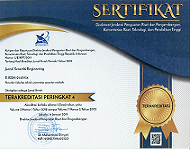Pengaruh Variasi Komposisi dan Tekanan Alat Press Mini Produk Terhadap Mechanical Properties Produk Papan Silikat Skala Mini (Studi Kasus di PT XYZ)
Keywords:
mini produk, moisture, absorption, papan silikatAbstract
Silicate board is one of the products produced at PT XYZ. This material is resistant to water and fire, making it very useful in building construction. In addition, silicate board can be used as an alternative to bricks or gypsum because it is easier to apply. The manufacture of silicate board requires the right combination of compositions to suit industrial needs. This study aims to analyze the effect of variations in composition and pressure in the process of making small-scale silicate boards (mini products). Mini products are made in several samples with different combinations of composition and pressure. In the study, cement compositions were used with percentages of 30%, 32%, and 34% at each pressure. Meanwhile, the pressure applied was 60 bar and 70 bar for each composition. The analysis parameters include the Modulus of Rupture (MOR), Moisture content, Water absorption, and density values in each sample. The results of the study showed fluctuations in these values based on variations in composition and pressure. However, there was one sample that consistently had the highest value in various aspects. This finding indicates that the combination of composition and pressure must be adjusted properly to produce silicate boards with optimal quality.
References
[1] L. Kristanto, H. Sugiharto, S. W. D. Agus, and S. A. Pratama, “Calcium Silicate Board as Wall-facade,” in Procedia Engineering, Elsevier Ltd, 2017, pp. 679–688. doi: 10.1016/j.proeng.2017.01.409.
[2] Y. Wang, Y. J. Chuang, and C. Y. Lin, “The Performance of Calcium Silicate Board Partition Fireproof Drywall Assembly with Junction Box under Fire,” Advances in Materials Science and Engineering, vol. 2015, 2015, doi: 10.1155/2015/642061.
[3] S. K. S. Hossain and P. K. Roy, “Development of sustainable calcium silicate board: Utilization of different solid wastes,” Boletín de la Sociedad Española de Cerámica y Vidrio, vol. 58, no. 6, pp. 274–284, Nov. 2019, doi: 10.1016/J.BSECV.2019.06.003.
[4] D. Marchon and R. J. Flatt, “Mechanisms of cement hydration,” Science and Technology of Concrete Admixtures, pp. 129–145, Jan. 2016, doi: 10.1016/B978-0-08-100693-1.00008-4.
[5] K. L. Scrivener, “SPECIAL ISSUE-Future Cements Options for the future of cement,” 2014.
[6] S. S. Panagoda et al., “Cement Manufacturing Process and Its Environmental Impact,” 2023. [Online]. Available: https://www.researchgate.net/publication/372364566
[7] X. Jin, J. Wang, and Q. Meng, “Developing a Calcium Silicate Prefabricated Board Ventilated Wall for Building Energy Efficiency Retrofit in Hot-Humid Areas,” IOP Conf Ser Earth Environ Sci, vol. 668, no. 1, p. 12022, Feb. 2021, doi: 10.1088/1755-1315/668/1/012022.
[8] J. Sheng, M. Zhang, R. Yang, W. Xie, and Y. Wang, “High-Performance Calcium Silicate Board Reinforced by Microfibrillated Cellulose/Microsilica,” ACS Sustain Chem Eng, vol. 11, no. 18, pp. 7053–7061, May 2023, doi: 10.1021/acssuschemeng.3c00099.
[9] Nurhidayati, R. Y. Lestari, I. D. G. P. Prabawa, N. Nurmilatina, F. E. Hasfianti, and S. Hamdi, “Physical Properties Evaluation of Calcium Silicate Cement Board Based on Indonesia Local Kaolin,” in Proceedings of the Conference on Broad Exposure to Science and Technology 2021 (BEST 2021), Atlantis Press, 2022, pp. 387–390. doi: 10.2991/aer.k.220131.057.
[10] H. Garbalińska, J. Strzałkowski, and A. Stolarska, “Moisture Influence on Compressive Strength of Calcium Silicate Masonry Units–Experimental Assessment and Normative Calculations,” Materials, vol. 13, no. 17, 2020, doi: 10.3390/ma13173817.
[11] Z. Cao, Y. Cao, J. Zhang, C. Sun, and X. Li, “Preparation and characterization of high-strength calcium silicate boards from coal-fired industrial solid wastes,” International Journal of Minerals, Metallurgy, and Materials, vol. 22, no. 8, pp. 892–900, 2015, doi: 10.1007/s12613-015-1147-2.
[12] V. Y. Palagala, J. D. Bhanushali, and M. Nithyadharan, “Characterization studies on calcium silicate boards and fibre cement boards used as sheathing in light gauge steel framed systems,” Structures, vol. 51, pp. 684–706, May 2023, doi: 10.1016/j.istruc.2023.03.036.
[13] L. Kristanto, H. Sugiharto, S. W. D. Agus, and S. A. Pratama, “Calcium Silicate Board as Wall-facade,” Procedia Eng, vol. 171, pp. 679–688, Jan. 2017, doi: 10.1016/J.PROENG.2017.01.409.
[14] K. L. Scrivener, “SPECIAL ISSUE-Future Cements Options for the future of cement,” 2014.
[15] Tuominen Olli, Tuominen Eero, Vainio Maarit, Ruuska Tiina, and Vinha Juha, “Thermal and moisture properties of calcium silicate insulation boards,” MATEC Web Conf., vol. 282, p. 2065, 2019, doi: 10.1051/matecconf/201928202065.
[16] C. T. Do, D. P. Bentz, and P. E. Stutzman, “Microstructure and Thermal Conductivity of Hydrated Calcium Silicate Board Materials,” J Build Phys, vol. 31, no. 1, pp. 55–67, 2007, doi: 10.1177/1744259107079020.
[17] P. Cao, L. Xing, J. Luo, H. Jiang, X. Zhang, and G. Li, “Preparation of calcium silicate board from tobermorite-rich residue for energy conservation in buildings,” Constr Build Mater, vol. 407, p. 133547, Dec. 2023, doi: 10.1016/J.CONBUILDMAT.2023.133547.
Downloads
Published
Issue
Section
License
Copyright (c) 2025 Aldiana Bayhaqi Ilham, Sarah Dampang (Author)

This work is licensed under a Creative Commons Attribution 4.0 International License.












